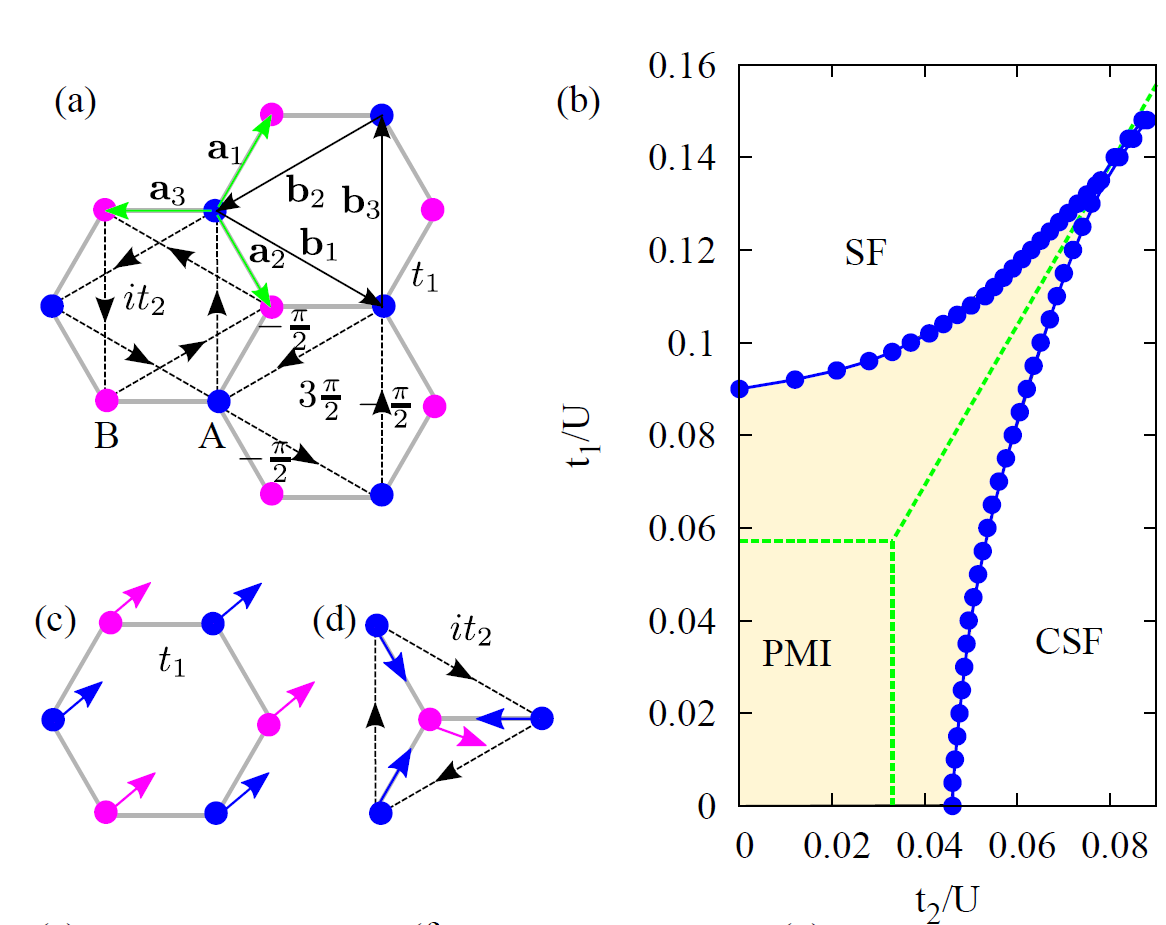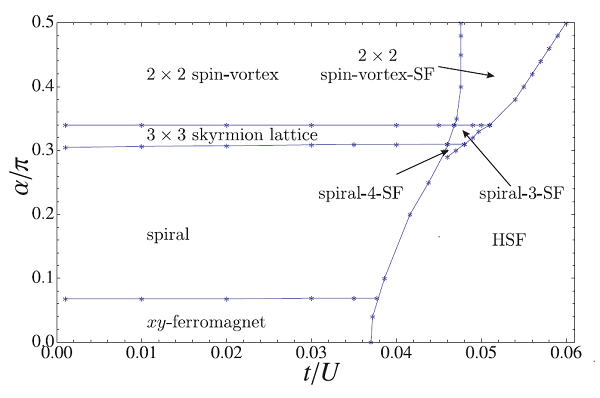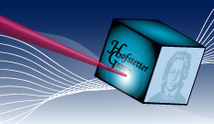Topological states with artificial gauge fields
Since the experimental realization of synthetic gauge fields for neutral atoms, the simulation of topologically non-trivial phases of matter with ultra-cold atoms has become a major focus of cold atom experiments [1]. They may even be generalized to simulate spin-orbit couplings or non-Abelian fields [2]. Recently, experimental realization of the topological Haldane model with ultra-cold fermions [3] and measurement of the Chern number of Hofstadter bands with ultra-cold bosonic atoms [4] have been achieved. Correlation-induced topological states and their stability in the presence of interactions present new challenges [5].
In some of our recent work, we have theoretically explored topological states and interaction effects for fermionic [6, 7] and bosonic [8] ultracold atomic systems.
-
Topological States and Exotic Magnetism of Ultracold Fermions
We investigate the time-reversal-invariant Hofstadter-Hubbard model as given in following equation. We include an additional staggered lattice potential and an artificial Rashba-type spin-orbit coupling term available in experiments [6]. Without interactions, the system exhibits various phases such as topological and normal insulator, metal and semi-metal phases with two or even more Dirac cones. We combine real-space dynamical mean-field theory and analytical techniques to discuss the effect of on-site interactions and determine the corresponding phase diagram. We investigate the semi-metal to anti-ferromagnetic insulator transition and the stability of different topological insulator phases in the presence of strong interactions. We compute spectral functions which allow us to study edge states of strongly correlated topological phases.
|
|
For U = 0, we distinguish the normal (NI) and topological (TI) insulating phases by calculating the Z2 invariant using Hatsugai’s method [9]. For finite interactions, we identify the phases by computing the spectral function in a cylindrical geometry using RDMFT and counting the number of gapless helical edge states crossing the bulk gap. The TI phase exhibits an odd number of helical Kramer’s pairs per edge while the NI phase has an even number. In Figure 1 (in the left panel), the spectral function show the evolution of one pair of edge states with interaction; indicating a transition to the topological insulating (TI) phase.
|
|
| Figure 1 |
For large values of the interaction strength, the system exhibits exotic non-collinear magnetism that can be tuned by varying the spin mixing (Figure 1, right panel). The spiral magnetic ordering can be understood by an effective spin model derived from the Hofstadter-Hubbard Hamiltonian.
-
Chiral Bosonic Phases on the Haldane Honeycomb Lattice
We investigate the Haldane honeycomb lattice tight-binding model for bosons with local interactions at an average filling of one boson per site. We apply bosonic dynamical mean field theory and exact diagonalization to obtain the results. The Hamiltonian is given by
|
|
The t2 term includes a complex phase for the tunneling between two next nearest neighbors. The absolute value of complex phase is constant throughout the lattice and the net flux per unit cell is zero (Figure 2a). U is the local interaction term. Each of the hopping terms and the interaction term favors one of the phases depicted in the diagram (figure 2b). The t1-dominated phase is a uniform superfluid (SF) with long range phase correlations, whereas the t2-dominated phase is a chiral superfluid (CSF) that exhibits phase modulation due to bosons condensing at nonzero momentum. The interaction dominated phase is a plaquette Mott insulator (PMI) characterized by local plaquette currents. These are connected either by a first order transition in the weakly interacting regime, or via two second order Mott insulator transitions in the strongly interacting regime. Different physical properties of the phases are reflected in the ground state density fluctuations and plaquette currents between the next-nearest neighbors and are accessible in ultracold atom experiments.
|
|
| Figure 2 |
Bose-Bose Mixtures with synthetic Spin-orbit Coupling
We investigate ground state properties of Bose-Bose mixtures with Rashba-type spin-orbit (SO) coupling on a square lattice. The resulting two-component Bose-Hubbard model in the lowest band approximation can be written as
|
|
The system displays rich physics from the deep Mott-insulator (MI) all the way to the superfluid (SF) regime. In the deep MI regime, novel spin-ordered phases arise due to the effective Dzyaloshinskii-Moriya interactions. By employing the non-perturbative bosonic Dynamical Mean-Field-Theory (BDMFT), we numerically study and establish the stability of these magnetic phases with increasing hopping amplitude. The corresponding phase diagram is given as
|
|
| Figure 3 |
|
|
References:
[1] J. Dalibard et al., Rev. Mod. Phys. 83, 1523 (2011).
[2] A. M. Dudarev et al., Phys. Rev. Lett. 92, 153005 (2004).
[3] G. Jotzu et al Nature 515, 237240 (2014).
[4] M. Aidelsburger et al Nature Physics 11, 162166 (2015).
[5] M. Hohenadler and F. F. Assaad J. Phys.: Condens. Matter 25 (2013) 143201.
[6] P.P. orth et al, J. Phys. B: At. Mol. Opt. Phys. 46 (2013) 134004
[7] D. Cocks et al, Phys. Rev. Lett. 109, 205303 (2012).
[8] I. Vasic et al Phys. Rev. B 91, 094502 (2015).
[9] T. Fukui and Y. Hatsugai, Phys. Rev. B 75, 121403 (2007).












